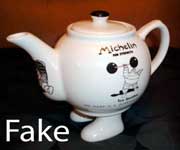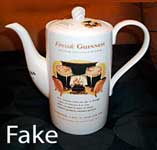
Previous Articles 4
Below are selected articles published on this site August - December 2009. We hope you will find some of interest.
Articles here have been moved from our Recent Articles & Announcements page and are in reverse chronological order.
Tuesday 22 December 2008
Spot the difference
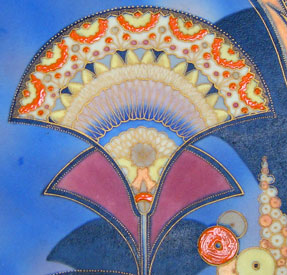
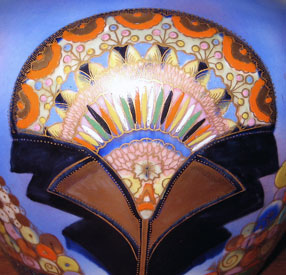
Further to our previous report on the Egyptian Fan charger sold at Reeman Dansie, above we show a comparison with part of the same pattern from a vase (right picture - the pattern appears distorted because of the curvature of the vase). The differences are clear. The charger, has only orange raised enamels (all other colours appear to be underglaze), and raised enamels are not present in the middle section of the fan. Also, the secondary fan is mauve and not gold. Similar differences are evident on other parts of this fabulous pattern. Let us know if you have any thoughts on why there are differences by
Thanks to Barry and Elaine Girling, as well as Ian and Jerome, for sending the images.
In the New Year, after Harvey, our Webmaster returns from Scotland he will use Egyptian Fan as our next featured pattern showing its variants. If you are lucky enough to have an example, do send us pictures for inclusion.
Thanks to Barry and Elaine Girling, as well as Ian and Jerome, for sending the images.
In the New Year, after Harvey, our Webmaster returns from Scotland he will use Egyptian Fan as our next featured pattern showing its variants. If you are lucky enough to have an example, do send us pictures for inclusion.
Scroll down for more.

Saturday 19 December 2009
nevetswogzalg (Glazgow Steven backwards) at it again.
Below are the latest offerings of Carlton Ware fakes from eBay seller nevetswogzalg. As usual, they are advertising ware. The Michelin advert on the walking teapot is a departure from the more usual Guinness fakes. It appears that the fakers are scanning Guinness and other adverts from magazines and having them made into slide-on lithographs, which are then used on a multitude of non Carlton Ware shapes with a fake Script Carlton Ware backstamp. Expect more....
To view these items on eBay, click on the images.
Scroll down for more.
Sunday 13 December 2008
Fan de siècle!

Last week we reported on a Phoenix charger sold by the auction house of Reeman Dansie. In the same sale, the Egyptian Fan charger shown on the left was was also offered.
This version of the exuberant Art Deco pattern has an unusual background, which is spotted in pale blue, mauve and a darker blue, and was allocated the pattern number 3697. This is not to be confused with the similar 3696 which uses the same background colours but without the spotted effect.
Several people have contacted us suspecting that the decoration is unfinished, because of the lack of gold, usually found on this pattern. Some of the raised enamels also appear to be missing.
Unfortunately, none of us from Carlton Towers were able to view the sale and thus handle the charger, so we only have the saleroom's image on which to comment. From this picture, we would tend to agree that it is incomplete, but before confirming this, we appeal to anyone who is lucky enough to have an example of this pattern to send us a picture so that a comparison can be made. You can send us an image by If the buyer of the charger reads this article, we would be most grateful for some better pictures, which could help us come to an accurate conclusion.
This version of the exuberant Art Deco pattern has an unusual background, which is spotted in pale blue, mauve and a darker blue, and was allocated the pattern number 3697. This is not to be confused with the similar 3696 which uses the same background colours but without the spotted effect.
Several people have contacted us suspecting that the decoration is unfinished, because of the lack of gold, usually found on this pattern. Some of the raised enamels also appear to be missing.
Unfortunately, none of us from Carlton Towers were able to view the sale and thus handle the charger, so we only have the saleroom's image on which to comment. From this picture, we would tend to agree that it is incomplete, but before confirming this, we appeal to anyone who is lucky enough to have an example of this pattern to send us a picture so that a comparison can be made. You can send us an image by If the buyer of the charger reads this article, we would be most grateful for some better pictures, which could help us come to an accurate conclusion.


Coincidently, at our Stoke Get-together in October, Derek and Jane Towns brought along an unfinished Egyptian Fan charger to show us, with the same pattern number, which you can see on the right. This would have been rejected because of the glaze flaws that are evident on the rim.
The flaw occured earlier in the decorating process than on the other charger. The pattern has been printed onto the biscuit, the underglaze painting has been applied and the charger subsequently dipped into a matt glaze. After firing, the flaw then appeared.
The flaw occured earlier in the decorating process than on the other charger. The pattern has been printed onto the biscuit, the underglaze painting has been applied and the charger subsequently dipped into a matt glaze. After firing, the flaw then appeared.
Whilst we are the subject of unfinished wares, below we show an incomplete and complete version of Eden 4242, both of which appeared on eBay recently.
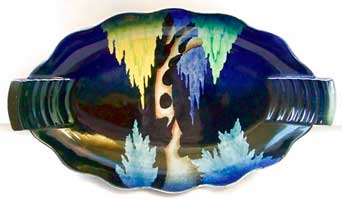

The incomplete example is missing its gold print, raised enamels and lustre finish. The reason for the rejection is not evident from the image, but there will be one. © Harvey Pettit 2009
We wrote an article on unfinished wares back in February 2009. You can view it from one of our Past News pages by clicking here. The article is titled Unfinished Business.
Scroll down for more.

Friday 11 December 2008
Clock this one...


A little while back we warned you of the deceitful taking old, unbranded ceramics and adding Carlton Ware marks to them.
The clock here, probably continental in origin, is a good example.
The fakers have added a fake swallow mark to the face of the clock and a fake crown mark to the back. Carlton Ware is also added below what is probably an original makers pattern number of 7322.
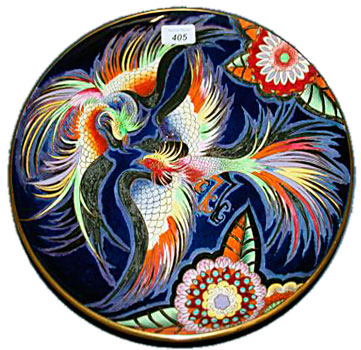
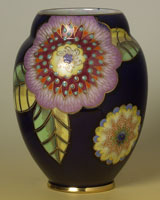
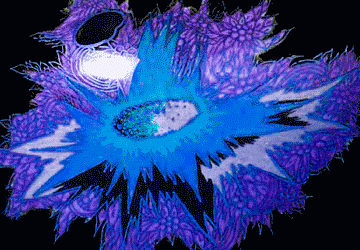


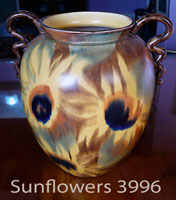
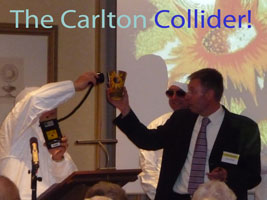
On the left, Terry tests Carole's Sunflowers vase, suitably protected!
You might recognise the image in the animation above as part of Carlton Ware's Explosions pattern, devised by Violet Elmer in the early 1930s. She was ahead of her time!
Fans of Richard Strauss can replay his Thus Spake Zarathustra by clicking the replay button.


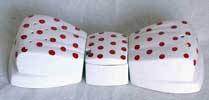
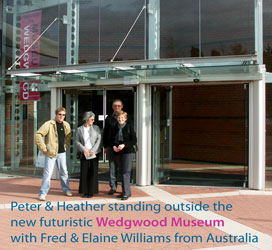


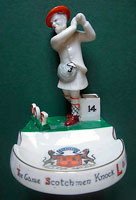
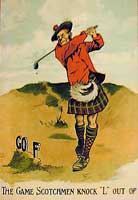
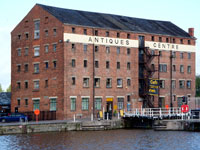
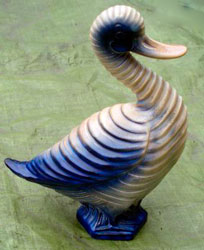

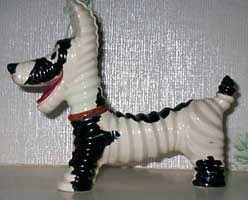
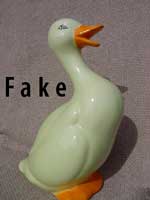
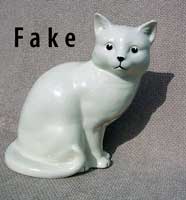
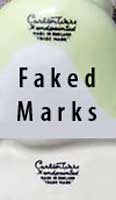
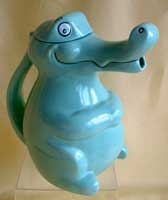

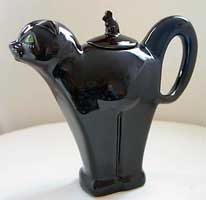
 ❑
❑

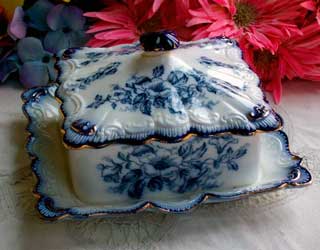
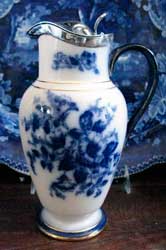
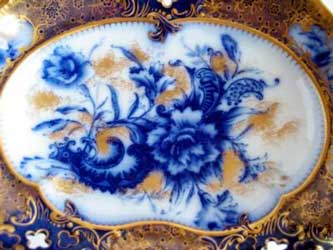
The clock here, probably continental in origin, is a good example.
The fakers have added a fake swallow mark to the face of the clock and a fake crown mark to the back. Carlton Ware is also added below what is probably an original makers pattern number of 7322.
Scroll down for more.
Tuesday 8 December 2008
Rising from the fire of the Copeland Street kilns

This unusual Carlton Ware charger appeared for sale yesterday at the auction house of Reeman Dansie in Colchester here in the UK.
The pattern is called Phoenix and accompanies many other Carlton Ware patterns featuring exotic birds.
Wikipedia tells us that the phoenix is a mythical bird with a colourful plumage and a tail of gold and scarlet. At the end of its long life cycle it builds itself a nest that then ignites; both nest and bird burn fiercely and are reduced to ashes, from which a new, young phoenix or phoenix egg arises, reborn anew to live again.
The design is one of Violet Elmer's, and here, as in some of her other work, she creates shadows of the main features of the pattern.
The pattern is called Phoenix and accompanies many other Carlton Ware patterns featuring exotic birds.
Wikipedia tells us that the phoenix is a mythical bird with a colourful plumage and a tail of gold and scarlet. At the end of its long life cycle it builds itself a nest that then ignites; both nest and bird burn fiercely and are reduced to ashes, from which a new, young phoenix or phoenix egg arises, reborn anew to live again.
The design is one of Violet Elmer's, and here, as in some of her other work, she creates shadows of the main features of the pattern.

The silhouettes appear to be in on-glaze black, although on the charger you can see that there has been some oxidization, which is evident as a white film and can occur with the passage of time.
The design is is even more exuberant than the work of William de Morgan, who favoured the depiction of mythical creatures.
The enamelled flowers and leaves on the edge of the charger were used on another pattern, namely Melange 3601, as shown on the vase to the right. The flowers are also typical of Violet Elmer's work.
© Harvey Pettit 2009
Information on pattern identification provided by The Cochrane & Pettit Archive of Carlton Ware.
The design is is even more exuberant than the work of William de Morgan, who favoured the depiction of mythical creatures.
The enamelled flowers and leaves on the edge of the charger were used on another pattern, namely Melange 3601, as shown on the vase to the right. The flowers are also typical of Violet Elmer's work.
© Harvey Pettit 2009
Information on pattern identification provided by The Cochrane & Pettit Archive of Carlton Ware.
Scroll down for more.
Saturday 21 November 2009
Results from the Carlton Collider!

Click the triangular play button on the control panel below to hear sound.
Today, the Hadron Collider near Geneva was switched back on after fourteen months of repairs. Let's hope the team get the results they are looking for.
So what about results for the Carlton Collider experiments that we ran at our Stoke Get-together last month and why did we go to all this trouble, apart from a bit of fun?
So what about results for the Carlton Collider experiments that we ran at our Stoke Get-together last month and why did we go to all this trouble, apart from a bit of fun?
In August last year, we received the following question from Mike in America.
Did Carlton Ware ever use uranium or uranium compounds in any of its products? I am concerned, because a friend asked me to store (at my residence) several boxes of fairly old china.
Did Carlton Ware ever use uranium or uranium compounds in any of its products? I am concerned, because a friend asked me to store (at my residence) several boxes of fairly old china.

Mike wanted to know if Carlton Ware was radioactive and was it safe to have in his home! Thus, to investigate, the 'Carlton Collider' was created.
The vast majority of Carlton Ware shows no radioactivity, but we suspected some could. Any radioactivity will come not from the pot itself, but from its glaze. We knew that the so-called fruit-skin glazes used by Pilkington's Royal Lancastrian Pottery were radioactive, especially an orange vermillion glaze, which they used in the 1930s. An example is shown on the right. So, did Carlton Ware produce pots with a similar glaze? The answer is yes, as you can see from the picture below. We were lucky to find an example to test since they were made in small numbers.
The vast majority of Carlton Ware shows no radioactivity, but we suspected some could. Any radioactivity will come not from the pot itself, but from its glaze. We knew that the so-called fruit-skin glazes used by Pilkington's Royal Lancastrian Pottery were radioactive, especially an orange vermillion glaze, which they used in the 1930s. An example is shown on the right. So, did Carlton Ware produce pots with a similar glaze? The answer is yes, as you can see from the picture below. We were lucky to find an example to test since they were made in small numbers.

Using a professional Geiger counter, kindly supplied by David Mcintosh, we tested our example and sure enough, the counter merrily clicked away at a fast rate of knots.
Since the decoration is rare, we estimate there is at most a one in fifty thousand chance of Carlton Ware being radioactive. To illustrate this we tested some of the other items of Carlton Ware, not expecting to get any readings from the Geiger counter, but to our great surprise an unusual vase decorated with the Sunflowers decoration, which Carole Moore had brought along to show us also gave a high reading.
Since the decoration is rare, we estimate there is at most a one in fifty thousand chance of Carlton Ware being radioactive. To illustrate this we tested some of the other items of Carlton Ware, not expecting to get any readings from the Geiger counter, but to our great surprise an unusual vase decorated with the Sunflowers decoration, which Carole Moore had brought along to show us also gave a high reading.

An example of Sunflowers is shown on the right. This too is an unusual glaze decoration, so such decorations are worthy of further investigation. We guess we will have to call them the Radioactive Range!
Both decorations were introduced in the 1930s and will have contained uranium oxide or sodium urinate in their glazes.
The use of uranium in ceramic glazes ceased during World War II. Health risks are not associated with the radiation but from the ingestion of uranium that could leach into food or drink in contact with pottery. So don't drink your favourite tipple from your Carlton Ware! 'Bottoms up' only to look at the backstamp.
Both decorations were introduced in the 1930s and will have contained uranium oxide or sodium urinate in their glazes.
The use of uranium in ceramic glazes ceased during World War II. Health risks are not associated with the radiation but from the ingestion of uranium that could leach into food or drink in contact with pottery. So don't drink your favourite tipple from your Carlton Ware! 'Bottoms up' only to look at the backstamp.

On the left, Terry tests Carole's Sunflowers vase, suitably protected!
You might recognise the image in the animation above as part of Carlton Ware's Explosions pattern, devised by Violet Elmer in the early 1930s. She was ahead of her time!
Fans of Richard Strauss can replay his Thus Spake Zarathustra by clicking the replay button.
Scroll down for more.
Saturday 14 November 2009
Whatever Happened to the Teapots?

This week, BBC Radio Four broadcast a series of five 15 minute programmes called Whatever Happened to the Teapots.
In the 1980s, Roger Law of Spitting Image fame, went to Stoke-on-Trent see about getting get some novelty Margaret Thatcher teapots made. They were of course made by Carlton Ware. Roger returns to meet up with the craftsmen who helped him get a handle on Mrs T.
In the 1980s, Roger Law of Spitting Image fame, went to Stoke-on-Trent see about getting get some novelty Margaret Thatcher teapots made. They were of course made by Carlton Ware. Roger returns to meet up with the craftsmen who helped him get a handle on Mrs T.

Roger began the series by visiting the Potteries Museum in Hanley, where he found some Fluck & Law Spitting Image pots behind a ceramic bow tie cruet, another Carlton Ware creation from the same period. Roger made the clay models for the Spitting Image characters but the moulds for them were made by Graham Lawton of Brunswick Ceramic Services and then used at Copeland Street.
Throughout the series Roger talked to many people working in Stoke-on-Trent about the state of the Pottery Industry today. We provided links to the BBC iPlayer so that you could listen to these programs over the Internet, though these are now no longer available.
Throughout the series Roger talked to many people working in Stoke-on-Trent about the state of the Pottery Industry today. We provided links to the BBC iPlayer so that you could listen to these programs over the Internet, though these are now no longer available.

In the series, describing Stoke-on-Trent, Paul Atterbury exclaims Here is a city about innovation which has invented some of the greatest materials in ceramic history... white earthenware, bone china... slipware. Paul continues We do quirky, my god do we do quirky; Britain has given the world eccentricity, humour, and fun. He could be talking just about Carlton Ware!
Scroll down for more.
Wednesday 28 October 2009
Annual Stoke-on-Trent Get-together 2009

The weekend began with the optional Saturday events, and a visit to The Firs, in Newcastle-under-Lyme, Cuthbert Wiltshaw's home in the 1920s. We then travelled to the new fantastic and futuristic Wedgwood Museum, where we had lunch before taking a tour of the Twentieth Century galleries.
We were delighted to welcome Fred and Elaine Williams from Australia, who had been scouring the country for pots - you can guess the make!
The new format of the main day on Sunday, with leisurely optional Saturday events, proved popular, so we will repeat this successful formula next year, which will be 10 October 2010 - 10-10-10!
We were delighted to welcome Fred and Elaine Williams from Australia, who had been scouring the country for pots - you can guess the make!
The new format of the main day on Sunday, with leisurely optional Saturday events, proved popular, so we will repeat this successful formula next year, which will be 10 October 2010 - 10-10-10!

Sunday's programme began at 9am, though next year perhaps we won't start quite so early, but there was a lot to do. We had three talks in the morning and numerous entertainments in the afternoon. As usual, we were joined by former employees, one of the highlights of the weekend.
Believe it or not, the picture on the right was taken after lunch. Had Josiah Wedgwood come to join us, since we were in Etruria Hall, once his home?
If you are intrigued, you can read more from the pens of Tony Wood and Derek Towns by clicking on their names.
Believe it or not, the picture on the right was taken after lunch. Had Josiah Wedgwood come to join us, since we were in Etruria Hall, once his home?
If you are intrigued, you can read more from the pens of Tony Wood and Derek Towns by clicking on their names.
Scroll down for more.
Monday 12 October 2009
Annual Staffordshire Get-together & AGM.
Annual Staffordshire Get-together & AGM.

We hope all who joined us for our premier event at Etruria Hall at the weekend had a safe journey home. We were especially delighted to welcome Fred and Elaine from Australia, who told us that they thoroughly enjoyed themselves.
As always, we invited former employees to join us on the Sunday afternoon and they were thrilled to see a film of the works made in the 1950s. Rose Hampson, now aged 92, who joined the works in 1931, had travelled all the way from Devon to be with us. Her recollections of her times on the works had us in fits of laughter.
There is too much to report about the weekend here, so we will post a fuller account on a separate page shortly.
As always, we invited former employees to join us on the Sunday afternoon and they were thrilled to see a film of the works made in the 1950s. Rose Hampson, now aged 92, who joined the works in 1931, had travelled all the way from Devon to be with us. Her recollections of her times on the works had us in fits of laughter.
There is too much to report about the weekend here, so we will post a fuller account on a separate page shortly.
Scroll down for more.
Sunday 6 September 2009
Scottish Gathering - it's a knockout!


Bearing in mind our recent Scottish Gathering was last weekend, a fitting item of Carlton Ware appeared on eBay. It is part of CW's Heraldic China range and portrays a golfer in a kilt and Tam o'Shanter. The figure is part of a match holder and ashtray, as shown on the right.
The seller cleverly identifies the likely source of the model as the postcard we show next to it, which has the caption The Game Scotsmen Knock 'L' Out Of. This is also printed on the ashtray base. Amusingly, the 'L' is missing from the word golf at which the golfer is aiming.
We guess that the postcard dates from the early 1900s. The Carlton Ware match holder ashtray was registered as a design in 1926.
It sold for £184, plus p&p, reflecting the rarity and appeal of this smoking accessory.
The seller cleverly identifies the likely source of the model as the postcard we show next to it, which has the caption The Game Scotsmen Knock 'L' Out Of. This is also printed on the ashtray base. Amusingly, the 'L' is missing from the word golf at which the golfer is aiming.
We guess that the postcard dates from the early 1900s. The Carlton Ware match holder ashtray was registered as a design in 1926.
It sold for £184, plus p&p, reflecting the rarity and appeal of this smoking accessory.
Our Scottish gathering was fully booked, so to avoid disappointment book our events sooner than later. ❑
Scroll down for more.
Ian & Jerome's Newsletter No.46, from Canada.

Ian and Jerome's latest Newsletter recounts the first part of their recent lengthy trip to the UK. Read about how they scoured the country for Carlton Ware and other nice things. It's full of useful tips if you enjoy travelling the Sceptred Isle....
To see this latest edition click here. This is a bumper 16 page edition but we have made the file size (750KB) as small as possible for you, without any loss in quality. It should download quickly from our fast server. ❑
To see this latest edition click here. This is a bumper 16 page edition but we have made the file size (750KB) as small as possible for you, without any loss in quality. It should download quickly from our fast server. ❑
Scroll down for more.
Wednesday 19 August 2009
Some Animals are more equal than others!


In the mid 1930s Carlton Ware introduced six models of stylized animals.
These were part of the extensive RIBBED STONEWARE range, which also included a large number of vases and jugs.
The range was mostly decorated in plain glazes in various colours and combinations.
These were part of the extensive RIBBED STONEWARE range, which also included a large number of vases and jugs.
The range was mostly decorated in plain glazes in various colours and combinations.

The first animal to be made was a DOG, followed by a RAT, a GOOSE, a PENGUIN, a RABBIT, and a CAT ON ASHTRAY. The DOG is especially charming, and is shown on the right; this one has a more elaborate decoration.
The reason that we show the RIBBED STONEWARE GOOSE and CAT ON ASHTRAY,, above, is because a fake cat and duck has just been spotted on eBay although these are quite different beasts, as the pictures below show. They both have the typical faked black Script backstamps, also shown.
The reason that we show the RIBBED STONEWARE GOOSE and CAT ON ASHTRAY,, above, is because a fake cat and duck has just been spotted on eBay although these are quite different beasts, as the pictures below show. They both have the typical faked black Script backstamps, also shown.



The seller tells us that both have been 'stored in the loft for ten years'!
We would suggest that they are recently made.
You can view the duck by clicking here and the cat by clicking here.
Animals feature prominently in the Woods period, 1968-87, most notably with designs by Roger Michell and Danka Napiorkowska. Some of the last shapes to be introduced and made at Copeland Street, before the pottery closed in 1989, were teapots in the form of an alligator, hippo, cat and elephant, which we show below. These were modelled by Carlton Ware's resident modeller, not by Roger Michell.
We would suggest that they are recently made.
You can view the duck by clicking here and the cat by clicking here.
Animals feature prominently in the Woods period, 1968-87, most notably with designs by Roger Michell and Danka Napiorkowska. Some of the last shapes to be introduced and made at Copeland Street, before the pottery closed in 1989, were teapots in the form of an alligator, hippo, cat and elephant, which we show below. These were modelled by Carlton Ware's resident modeller, not by Roger Michell.



 ❑
❑ Scroll down for more.
Saturday 8 August 2009
Blue & White

One of the least appreciated aspects of early Carlton Ware
is its blue & white decorations, which Wiltshaw & Robinson (W&R) produced in tandem with Blushwares. Indeed, aside from a few exceptions, the same prints were used to the same high standards.
Perhaps, the most well known blue & white pattern is what has become known as the Willow Pattern, and, like so many potteries, W&R produced its own variant. The teapot on the right shows the Carlton Ware version, which, inevitably, was called WILLOW.
is its blue & white decorations, which Wiltshaw & Robinson (W&R) produced in tandem with Blushwares. Indeed, aside from a few exceptions, the same prints were used to the same high standards.
Perhaps, the most well known blue & white pattern is what has become known as the Willow Pattern, and, like so many potteries, W&R produced its own variant. The teapot on the right shows the Carlton Ware version, which, inevitably, was called WILLOW.


A variation of blue & white decorations is flow blue, which is thought to have originated in the 1820s. As its name suggests, the cobalt blue colour in which the pattern is printed flows into the clear glaze producing a pattern with a soft attractive outline.

W&R introduced beautiful blue & white and flow blue decorations in the early 1890s alongside its Blushware counterparts, and, bar the odd exception, production had ceased by the beginning of World War 1. The jug shown above, decorated with the Hibiscus pattern, has a sterling silver mount made by James Dixon & Sons and is hallmarked for 1909.
Even more attractive are variants embellished with gold, as on the CARNATION example on the right. Occasionally, W&R employed expensive and elaborate raised paste gilding, as well as white raised enamelling.
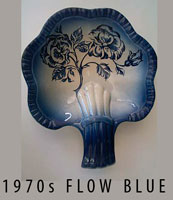
Even more attractive are variants embellished with gold, as on the CARNATION example on the right. Occasionally, W&R employed expensive and elaborate raised paste gilding, as well as white raised enamelling.

Shortly after Gerald Wood and his son, Anthony Wood, took over Carlton Ware in 1969, and whilst finding their feet with their new acquisition, they introduced a new blue & white pattern, although this was a lithographic decoration, probably bought in from one of the many litho makers.
Old-fashioned shapes were made specially for it. Edges to these shapes were highlighted in flow blue and unsurprisingly this out-of-time decoration was called FLOW BLUE. This was not Carlton Ware at its best and bears no comparison with the earlier wares. An example is shown on the left. As a primitive pastiche of an earlier style, the pattern was not a success. The Woods were soon to pull their socks up and quickly began to introduce original and exciting designs. © Harvey Pettit 2009.
Enthusiasts of flow blue decorations might like to look at the website of the American based
Flow Blue International Collectors Club. You can view it by clicking here. ❑
Old-fashioned shapes were made specially for it. Edges to these shapes were highlighted in flow blue and unsurprisingly this out-of-time decoration was called FLOW BLUE. This was not Carlton Ware at its best and bears no comparison with the earlier wares. An example is shown on the left. As a primitive pastiche of an earlier style, the pattern was not a success. The Woods were soon to pull their socks up and quickly began to introduce original and exciting designs. © Harvey Pettit 2009.
Enthusiasts of flow blue decorations might like to look at the website of the American based
Flow Blue International Collectors Club. You can view it by clicking here. ❑
Images by Harvey Pettit © Copyright 2009. All rights reserved.


